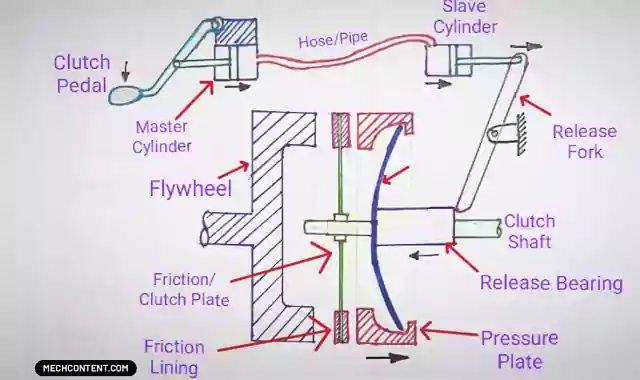What is a Hydraulic clutch?
A Hydraulic clutch is one of the types of Automobile clutch in which hydraulic fluid is used to actuate the clutch. The advantage of a hydraulic clutch is that it requires less effort to press the clutch pedal.
In this, the application of the clutch is smoother in comparison with mechanical clutches.
Continue reading to know about its construction and working.
In this article, we’re going to discuss:
- Construction:
- Hydraulic clutch working:
Construction:
The below figure shows the diagram of a hydraulic clutch system used in an automobile.

It consists of the following parts.
1) Flywheel: The flywheel is connected to the engine crankshaft. As the pressure plate presses the friction plate against the flywheel (engaged situation), power/torque transmits from the flywheel to the clutch shaft due to friction between plates & flywheel.
2) Pressure Plate: The pressure plate is used to press the friction plate against the flywheel. The diaphragm spring is used to keep pressure on the pressure plate.
3) Friction Plate: The Friction plate has friction lining on both sides surface. Pressure plate press the friction plate against the flywheel.
Hence contact was made between the pressure plate & flywheel. Friction between them is responsible for the power/torque transmission.
4) Diaphragm (diaphragm spring): The diaphragm has a circular shape. It is one of the types of spring. Its purpose is to keep pressure on the friction plate.
As compared to plate-type clutch, in the hydraulic clutch, the diaphragm is used at a place of spring to keep pressure on the pressure plate.
5) Release Bearing: It is mounted on a clutch shaft. When the driver presses the clutch pedal, through a linkage, the release bearing applies pressure on the diaphragm at the middle portion. It causes the clutch to disengage.
6) Release Fork: It is used to press release bearing against the diaphragm. One end of the release fork is attached to the piston rod of the slave cylinder & another end is attached to the clutch shaft.
7) Slave Cylinder: It is used to press the release fork. The piston rod of this slave cylinder is connected to the release fork. When fluid enters in slave cylinder, the piston presses the release fork.
8) Hose/Pipe: It is used to transfer fluid from the master cylinder to the slave cylinder to operate the clutch.
9) Master Cylinder: It is a hydraulic cylinder connected to the clutch pedal. When the driver presses the clutch pedal, the piston of the master cylinder forces hydraulic fluid into the slave cylinder through hydraulic lines.
10) Clutch Pedal: It is used to operate clutch when desired. The clutch pedal is connected to the master cylinder piston rod. When the clutch pedal is pressed, fluid presses & flows from the master cylinder to the slave cylinder to operate the clutch.
Hydraulic clutch working:
Let’s know how engagement and disengagement in the hydraulic clutch work.
DISENGAGEMENT:
When a vehicle is running (no pedal pressed), the clutch is in the engaged position. When the driver presses the clutch pedal, the piston of the master cylinder forces the fluid. It causes fluid to flow from the master cylinder to the slave cylinder through the hose/pipe.
When fluid enters the slave cylinder, the piston rod of the slave cylinder moves out. This piston rod pushes the release fork.
Then the release fork pushes the release Bearing to press the middle portion of the diaphragm to move toward the left side.
When the middle portion of the diaphragm is pushed (towards the left side), the outside part of the diaphragm moves in the opposite direction (towards the right side) and the pressure plate moves towards the right side.
Therefore pressure on the friction plate is removed. So no friction between the plates & flywheel and the clutch disengages. Hence no power transmission will take place.
ENGAGEMENT:
When the driver releases the clutch pedal, pressure on the fluid is removed, resulting in the diaphragm again coming to its original position.
Hence outside part of the diaphragm moves left side to press the pressure plate on the friction plate & flywheel.
Therefore friction occurs between them. Hence power/torque transmits from the flywheel to the clutch shaft. Here the clutch becomes Engaged.
Read also: